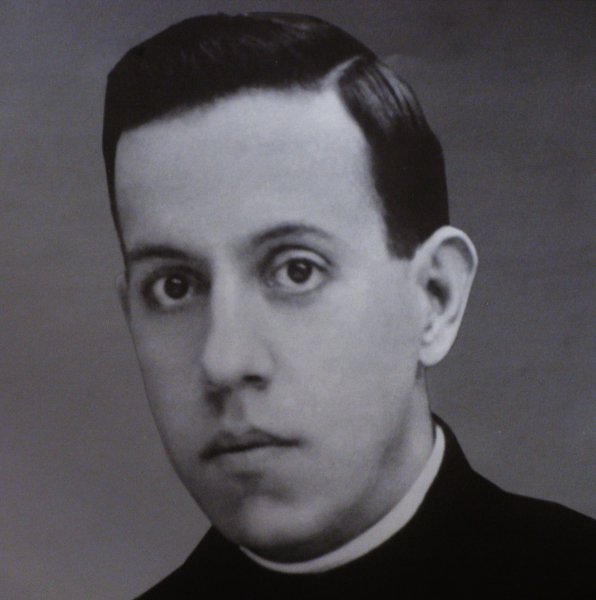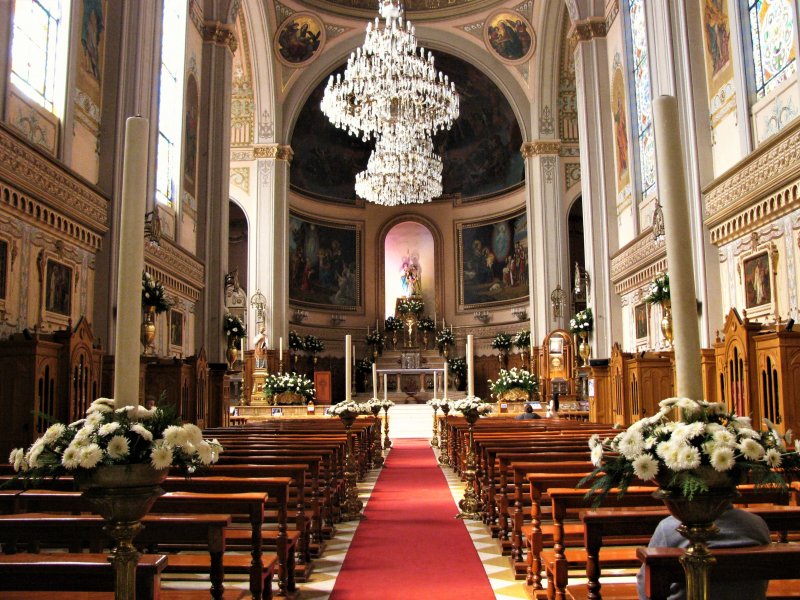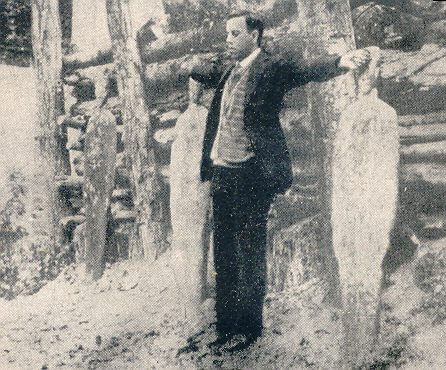Father Miguel Pro could have said “No.” His Jesuit superior ordered him back to Mexico for his health. After three unsuccessful stomach operations the superior thought that a return to his homeland would aid in his recovery. It is likely that the Superior was not aware of the perilous state of the country at that time, particularly for a Catholic priest. Father Pro, however, had no such illusions. He knew exactly what he would be facing. He had been in Europe for eleven years as it was considered too dangerous for him to continue his seminary training in his beleaguered homeland. He completed his theological education in Spain and Belgium and was ordained in 1925. He returned to Mexico in 1926.
 Miguel was born on Jan. 13, 1891 in the mining town of Guadalupe, Zacatecas where his father was a mining engineer. He was the third of seven children. The high-spirited, musical and ever-witty Miguel (“He could have made a fortune on the stage” said one acquaintance) joined the Jesuits as a novice at the age of 20. “Take all from me, Lord! Only give me souls!” he vowed at this time.
Miguel was born on Jan. 13, 1891 in the mining town of Guadalupe, Zacatecas where his father was a mining engineer. He was the third of seven children. The high-spirited, musical and ever-witty Miguel (“He could have made a fortune on the stage” said one acquaintance) joined the Jesuits as a novice at the age of 20. “Take all from me, Lord! Only give me souls!” he vowed at this time.
“He sailed back West like the great missionaries of old – to the blood-stained shores of his homeland – in which the Church of Mexico struggled with the powers of hell made manifest,” stated Mrs. George Norman in The Jester of God. Like St. Edmund Campion returning to Elizabethan England from Belgium, like St. Isaac Jogues returning to North America from France, so Father Pro returned to Mexico. To his glorious martyrdom.
To what was Father Miguel returning? It was a time in the country known as La Persecution Brutale under the leadership of the viciously anti-Catholic dictator Plutarco Calles who became President of the country in 1924. He was quite something this Calles. According to Saints and Sinners in the Cristero War, Calles “had a reputation for executing priests without trial – ninety of them during his four years as president. He was an atheist and he wore that as a badge of honor all his life.” Author Msgr. James T. Murphy says that “he attacked the Church with a fanaticism that often shocked foreign diplomats.”
U.S. Ambassador James Sheffield provides just such an example: he wrote a memo to the U.S. State department about Calles: “This president has become so violent on the religious question that he has lost control of himself. When this topic has been dealt with in his presence, his face turns red, and he has hit the table to express his hate and profound hostility toward the practice of religion.” This was the Mexico that to which Father Pro was returning in 1926.
Before he left Europe he asked permission to visit Lourdes. This was granted. He, “who had the devotion of the saints to Our Lady” declared, “it was the happiest day of my life.” He said that it was “all I expected and more.” He composed this prayer while at Lourdes: “May I spend my days near thee – what I ask, O sorrowful Virgin is to be close to thee, to stand near thee, to strengthen my soul by thy tears.” He offered the immolation of himself for the Church in Mexico. “My journey to Lourdes has given me courage,” he said. Which he would need in extraordinary abundance.
And so he departed Europe in July of 1926 “for the Virgin and the sunburnt wilds of my country.” He was entering the country at a time when the radical Constitution of 1917 (now being enforced with a terrible vengeance) struck blow after blow against the Catholic Church. According to Robert Royal in his Martyrs of the Twentieth Century, Mexico became the first “explicitly socialist, anti-religious revolutionary republic in the world.” Along with Soviet Russia, Republican Spain and Castro’s Cuba, “it became one of the Communist countries in the last century whose express purpose was the eradication of the Christian religion.”
The Constitution had stripped the Catholic Church of all its property. Article 24 of the Constitution decreed that all religious worship be regulated by the state. Churches were closed, and no priest was allowed to minister to the faithful. Article 3 secularized all education. Religious education was forbidden in all schools. Francis F. Kelley, Bishop of Oklahoma and Tulsa discussed the subject in his aptly-titled book, Blood Drenched Altars. He revealed the oath that the teachers in the state of Yucatan were forced to sign: “I solemnly declare myself an atheist, an irreconcilable enemy of the Roman Catholic religion and I will exert my efforts to destroy it.” Not all teachers complied. In the city of Aguascalientes all the teachers resigned. In the state of Michoacan “60 teachers resigned rather than teach as prescribed.”
Kelley refers to the case of the Minister of Education, a close friend of President Calles, whose “particular educational fad was sexual instruction. He sent out indecent pamphlets to the teachers.” (Does this sound familiar?)
Within a few days of his arrival in Mexico, the bishops of the country were forced to take unprecedented measures: On July 31, 1926, they ordered the removal of the Blessed Sacrament from all the churches rather than submit the Church to government control. With approval from the Holy See all Sacraments would be suspended in all the churches of the Republic. The bishops spoke out with anguished eloquence: “The life of the Church is that of its Founder. The Church of Mexico is abandoned today to its worst enemies; she is mocked, she is scourged, she is reduced to a state like death.” In the words of one author, “The great Good Friday for Mexico had begun.”
Thousands upon thousands flocked to Confession before the churches were closed. Newly-arrived Father Pro heard confessions by the hour in his Jesuit parish church, Holy Family, in Mexico City, to such an extent that he fainted twice. He said his last public Mass at Holy Family on July 31, 1926. From that day on the Church in Mexico went “underground.”

He organized “Communion stations” in which he distributed 300 Communions on a daily basis. His mode of transportation? His brother’s bicycle. “The last First Friday I distributed 1,200 Communions” he said. All at the risk of his life. He was forced to dress in disguise: sometimes as a student (his youthful looks were an asset in this regard); “My student’s swagger gets me off any amount of suspicion,” he said. At other times he dressed as a garage mechanic, a miner and a “dandy” sporting a long cigarette-holder and a flashy dapper suit. Always conscious of the 10,000 “spy” agents in the city who were employed by the Calles government. Discovery could mean torture, imprisonment or immediate death. Always attentive to the poor, he was the main support for almost 100 poverty-stricken residents of the city.
Father Pro never stopped hearing confessions: “I have heard confessions even in the jails and here I spend most of my time for they are filled with Catholics” he said as quoted by Fr. Wilfred Parsons, S.J., in Mexican Martyrdom. He also gave retreats, baptized countless infants, and blessed marriages. His calls to the sick were legendary. He knew the risks: He said “The Catholics have taken the defensive against Calles and the reprisals are going to be terrible above all in the city of Mexico. The first to suffer will be those who have put their fingers into the religion question. And I have put mine there up to the elbow!”
He spoke about the perils: “From all sides we receive news of attacks and reprisals; the victims are many; the number of martyrs grows every day. Oh, if only I could draw a winning number!” He knew well of what he was speaking: In the first week of May of 1926, alone, “there was the mass execution of 17 priests in Mexico City.”
Mrs. George Norman, in The Jester of God writes about Fr. Pro’s statements on the celebration of the Feast of Christ the King on Oct. 31, 1926; it took the form of a pilgrimage to The Basilica of Our Lady of Guadalupe. The Basilica remained open during the entire “reign of terror” in Mexico. Even the Calles government dared not close it!
The pilgrimage to the Basilica began at four in the morning and ended at 7:30 at night. An uninterrupted stream of people – eighty or eighty-four percent of the inhabitants of the city – passed before the blessed image of Our Lady of Guadalupe. I was there – it was impossible to tear myself away.
And all shouting along the way, “Viva Cristo Rey! Viva Cristo Rey! Viva La Virgen de Guadalupe! Viva La Virgen de Guadalupe!”
On the night of Nov. 15, 1927, Fr. Miguel and his two brothers, Humberto and Roberto were arrested. On the last night of his life he slept on the bare floor because he had given his “thin mattress” to a fellow prisoner. On the morning of Nov. 23, the sweater-clad priest was led out of his cell, holding his crucifix in one hand and his Rosary in the other. Facing the firing squad, with his arms extended in the form of a cross (he refused a blindfold), he kissed his crucifix and said: “May God have mercy on you. May God bless you.” His final words were “Viva Cristo Rey!” His brother Umberto was martyred the same day and his other brother Roberto was released and exiled to the United States.
A nun reported that a month before his death, Fr. Pro had confided to her that he had offered his life for souls and for the Church in Mexico.
Fr. Miguel Pro was beatified by St. Pope John Paul II in 1988.
Photos: public domain and provided by the author.


